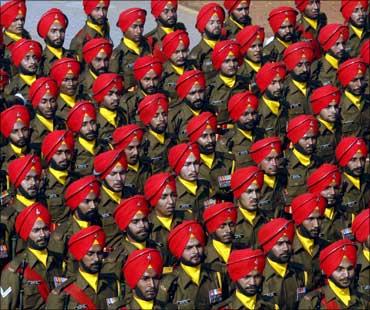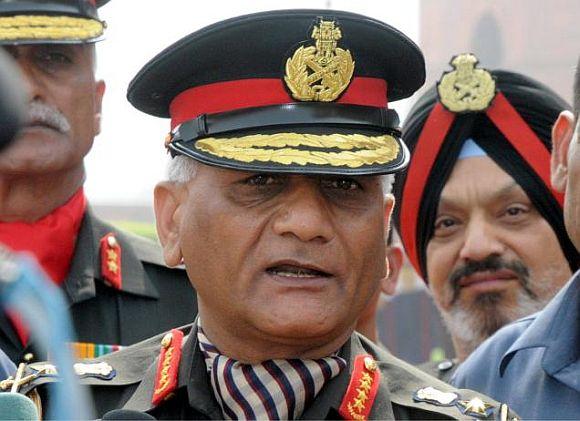 | « Back to article | Print this article |
India's civil-military relations: The threat within?
Students and observers of the Indian military and the structure of its relationship with the defence ministry, and the government of India unanimously agree that, over time, the boundaries of "objective control" have been breached says Ajai Shukla.
Was what happened on the night of January 16 really a "C" attempt? Was it a routine exercise or was the army chief playing mind games with the civilian administration?
It is a question to which we might never know the answer. Did the army chief arrange for two military units to "practise mobilisation" on the outskirts of New Delhi as a warning to his boss, Defence Minister A K Antony, on January 16? That was the day that General V K Singh took the unprecedented step of challenging the government in the Supreme Court on the controversy over his age.
It broke as a news storm on Wednesday. The Indian Express reported that political alarm bells had gone off in New Delhi on the foggy night of January 16 when intelligence agencies detected an army battalion from the Hisar-based 33 Armoured Division and a Special Forces unit from the Agra-based 50 (Independent) Parachute Brigade moving unexpectedly towards the capital.
ALSO READ: India's elite paratroopers meet their match in fog, traffic during mockup
According to the report, the government reacted to this "unexpected" and "non-notified" military move by recalling Defence Secretary Shashi Kant Sharma from Malaysia. Sharma arrived in Delhi and summoned the army's Director General of Military Operations, Lt Gen A K Choudhary, to a late-night meeting in his office to "explain what was going on". The general "was told to send the units back immediately". The report did not feature the word "coup", but instead highlighted "confusion and unease" within the top echelons of government at a time of a "strained... political-military relationship."
Click NEXT to read further...
For Realtime News on the Indian Army, click here
A pre-emptive demonstration with a cover plan
The army's outraged denials have been immediately challenged. Breaking ranks on Thursday, one of the army's most upright and cerebral recent generals, Lt General Harcharanjit Singh Panag, who was an army commander till he retired in 2009, suggested on Twitter that General Singh had engineered the move to spook the government into believing that a coup was possible if the government tried to sack him. Since the move of the two units was a legitimate training activity, malevolent intent could credibly be denied, suggested Panag. And with the units being given only innocuous training orders, just a handful of people need know the real intent of the move.
In five linked tweets, Panag termed the move a "demonstration", an action designed to "alter enemy decision-making". Deniability was created through a "Cover Plan" which Panag explained as "a credible cover to operations undertaken to deceive the enemy". The troops that participate in a military demonstration "do not know the real aim", but senior commanders do. Overall, said Panag, the move of the military units to New Delhi was "A Pre-emptive demonstration with a Cover Plan (sic)," which "implies acting before the enemy does to upstage him from implementing his strategy, plan or operations".
The government, the military, and even the media are treading carefully around what, if Panag is correct, could be termed a near-coup experience. Public discourse has referred coyly to "the C-word" with even Shekhar Gupta, The Indian Express's chief editor who co-authored the article, telling a probing TV anchor, "I used the C-word but I call it curious, not coup." Much of India's reluctance to intellectually confront and discuss the phenomenon of military coups appears to stem from the apprehension that public discussion might have a self-fulfilling effect, indirectly legitimising military interventionism and fuelling praetorian behaviour (the ancient Roman praetorian guard was an elite corps that eventually grabbed a political role).
Click NEXT to read further...
Gen Singh's confrontation working well for the military
Is this really a watershed event in the relationship between the government and the military? Will historians look back on January 16 as a key moment when General Singh challenged the government's processes in court, and simultaneously (if Panag is right) its steeliness and resolve on the highways to Delhi? For now it would appear that General Singh's confrontation with the government is working well for the military.
With sections of Parliament baying for blood, defence ministry officials are in a flurry of activity, clearing policies, procurements and promotions that had needlessly languished, in some cases for years.
On March 20, the ministry cleared the results of a promotion board for major generals which it had obdurately blocked for the preceding six months. On April 2, it cleared the long-delayed revision of the Defence Offset Policy. The same day, Antony reviewed equipment procurements, calling for quicker trials. Although finance has been a key instrument of civilian control over the armed forces, Antony suggested delegating greater financial powers to the services to catalyse speedier acquisition of equipment, platforms and systems.
The military's 15-year Long Term Integrated Perspective Plan, a crucial document that establishes a roadmap for indigenous development and procurement, could be cleared soon, say sources. And, with the Naresh Chandra Committee finalising its recommendations on defence preparedness and the restructuring of the higher defence organisation, insiders have begun betting that the government might soon accept the long-standing suggestion, offered by multiple committees and even a group of ministers, to install a chief of defence staff, a five-star general who will sit atop the tri-service pyramid.
For now, the army is flatly rejecting any link between the ongoing confrontation and the defence ministry's new sensitivity. Serving generals are even more emphatic in dismissing accusations emerging from The Indian Express article that General Singh exerted illegitimate pressure on the government.
Click NEXT to read further...
'Military coup would require support of 6 army commanders, air force chief'
Officers currently serving in army headquarters emphasise that it is wrong to say that there are protocols and regulations that require army movement, at any time, in the National Capital Region to be pre-notified to the defence ministry. "Army units move every day of the week towards Delhi, into Delhi and within Delhi. These include vehicle convoys of units going on firing or training exercises as well as vehicle convoys of units that are moving on transfer from one station to another, a journey that every combat unit makes in two or three years. These unit convoys often make administrative halts in Delhi," says a brigadier who coordinates army movements.
Serving officers also question how the move of two units (physically, just 500-odd men) to Delhi could possibly be seen as a threat, when two frontline infantry brigades and an artillery brigade (over 10,000 combat soldiers) are permanently located in the capital. This permanent garrison in Delhi was supplemented during that period in January by thousands of additional troops that had come to participate in the Army Day and Republic Day parades.
"Let's assume for a moment that some crazy army chief was bent on a coup, and wanted even more troops than were already in Delhi. Why would he move troops from Hisar (165 km away) and Agra (204 km away) when there is a full infantry division sitting in Meerut just 70 kilometers away," asks an officer.
A recently-retired lieutenant general, who wishes to remain anonymous because of the sensitivity of discussing even a hypothetical coup, points out that "any successful military coup would require the active support of all six geographical army commanders and also the air force chief. If even one army commander were not on board — and we would be foolish to assume that the incoming chief, Eastern Army Commander Lt Gen Bikram Singh, would associate himself with a military coup — any attempt could quickly degenerate into a fratricidal civil war between loyalists and rebels."
While a successful military coup may be hard to imagine in India, the issue that has sparked the current furore is not an actual coup attempt, but — as Panag implies — the suggestion of a putative attempt to armtwist a weakened government by the subtle application of military pressure. "It would be difficult, if not impossible, to determine conclusively the intention behind the move of these two units from Hisar and Agra. All that the paper trail will reveal is a chain of legitimate orders for a practice exercise. It is the intention behind this move that counts, and intentions lie in the mind," says a former army chief.
Just as cerebral are the government's perceptions that determine how it reacts at a particular moment. "I moved 3-4 complete divisions through Delhi at the time when we were pumping troops into Punjab to combat the insurgency," says the former chief. "That did not create even a moment of tension with the civil administration. But relations between the army and the government were on even keel then, and there was no suspicion between us."
Click NEXT to read further...
Influence of the civil bureaucracy is pervasive
It is for this reason that a country's civil-military relations must be based on well-established structures, procedures and spheres of influence, rather than on the mood of the moment that could shift on circumstances and events. In India, there is little understanding or public discussion of the demarcation between the government and the military, and the responsibility and connections between the two.
Samuel Huntington's masterpiece, his seminal 1957 book, The Soldier and the State, spells out the concept of "objective control" of the military. This model of civilian control, which is implemented in all successful modern democracies, allows the services full autonomy in their professional realm. A military that has ownership of its professional bailiwick, or so the "objective control" thesis postulates, does not involve itself in the political sphere. Civilian control, therefore, is asserted on broader political issues, rather than on day-to-day military functioning. In contrast, "subjective control" neutralises the military's influence through restrictive civilian controls, extending civilian oversight into spheres within the military's internal domain. Subjective control is predicated on "civilianising the military", while objective control aims at "militarising the military", encouraging professionalism and responsibility within its realm.
Students and observers of the Indian military and the structure of its relationship with the defence ministry and the government of India unanimously agree that, over time, the boundaries of "objective control" have been breached.
From long-term planning, to equipment procurement, promotions and dates of birth of army officers, the influence of the civil bureaucracy is pervasive. Ask any military officer his key resentment and there is near-certainty that he will name "the babu". While a military coup in India is hardly impending and the structures of parliamentary democracy seem likely to endure, grievance and resentment have been simmering within the officer corps.
Eric Nordlinger argues in another must-read masterpiece, Soldiers in Politics, Military Coups and Governments, that government failure is seldom more than a triggering condition for a coup. The actual causes of military intervention are civilian encroachment into what the military regards as its legitimate, four-fold sphere of corporate interests: adequate budgetary support, autonomy in managing internal affairs, preservation of its responsibilities in the face of encroachments from rival institutions, and the continuity of the military itself.
Is it time for a broader debate?






